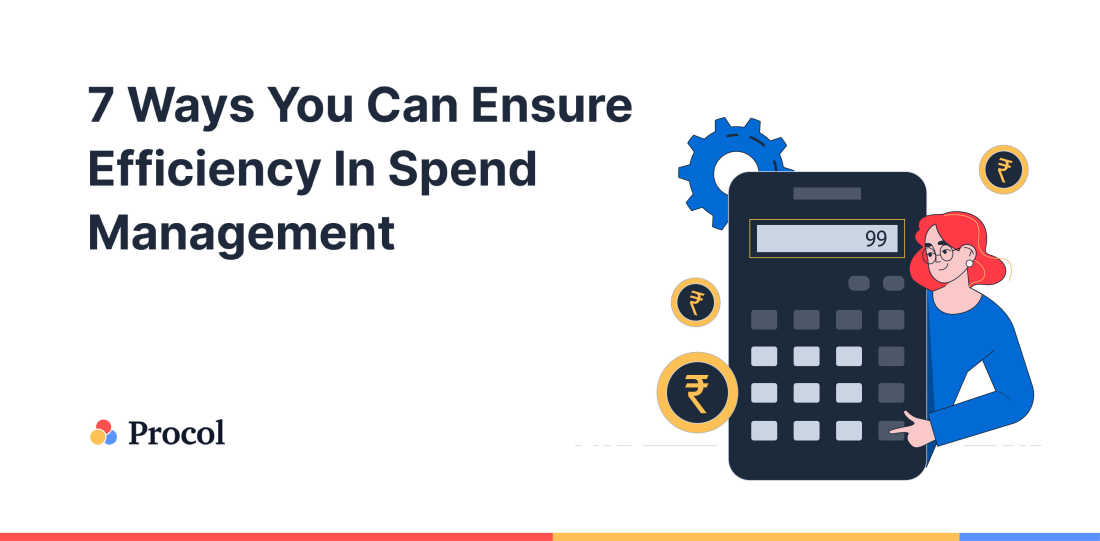7 Ways You Can Ensure Efficiency In Spend Management

What Is Spend Management?
It would appear that the more one’s income, the greater one’s desire to spend it. Keeping track of this spending while still turning a profit and producing high-quality results is a delicate balancing act. According to McKinsey, 40–80% of a business’s overall cost comes from purchases made outside the organisation.
Spend management is the process of controlling expenses in a way that saves money and time throughout the procurement process. Strategies for managing expenditures entail compiling, collecting, classifying, and assessing spent data to use the insights gained to guide decision-making in other areas.
Growing your business is impossible if you can’t keep your expenses in check. Companies lose an average of 2% every year owing to this flaw, according to studies.

Detailing the Methods of Spend Management
Step 1: Identify Sources of Expenditure
Employment-related costs include wages, housing, utilities, permits, promotion, insurance, and education. The type of a company determines its potential funding sources. Consequently, spending management is something every company must tackle uniquely.
Forty percent of UK firms blame poor financial processes for wasteful expenditure, while twenty-nine percent blame cost duplication. There must be a plan for where the money comes from, but it’s challenging to map out all the potential sources of spending. This problem can be solved with the help of a group of department heads or with the aid of automation at the source, which would eliminate redundancy.
Step 2: Centralise All Expenditure Data in a Repository
The accounts team often works with relevant teams to disseminate spending information. Not only does this include copious amounts of correspondence, but also physical documents.
By building and integrating management software, the accounts department may make it easier for all other departments to obtain firm spending data. Data audits are simplified since staff no longer need to manually go through numerous papers.
Expense information, however, is highly confidential and should not be shared across teams. Managers may set up procurement software to restrict access to sensitive financial data to those who need it.
Step 3: Verify & Cleanse Data
All data must be cleansed and checked before any conclusions can be drawn, even if the transactions were recorded accurately. Correcting inaccurate information in data requires identifying and eliminating it. Duplicates, missing information, or tainted files might contribute to inaccurate results. When data is verified, its integrity is maintained even after it has been transferred.
Step 4: Categorise Spend Data
Different kinds of expenditures are included in the data set. The needs and activities of a business dictate the need for such categorisation and labelling. The authorities’ prepared groupings must include all expenditures for a complete picture.
Data may be organised in several ways, each serving a different purpose. Information technology services, for instance, may be categorised as “Types of IT services” or labelled with the name of the company providing them. Spending data broken down by vendor or activity might help an organisation determine the most pressing requirements.
Step 5: Analyse Spend
After the information is organised, managers must examine spending reports to identify trends and outliers. You may also do statistical calculations in various departments at this stage.
Companies can analyse data in several ways, including assigning in-house workers to the task and bringing in outside experts. On the other hand, cutting-edge management software employs AI and machine learning for in-depth examinations. Reports can be customised to include any data an organisation deems relevant, such as ROI, cost-benefit evaluations, and personnel expenditures.
Step 6: Strategise And Execute
Put into action the adjustments that were discussed and agreed upon. If the project is implemented for the first time, it may be rolled out in stages, and spending data can be collected and evaluated on a departmental, if not an enterprise-wide, scale.
Successful change management involves buy-in and input from all parties affected by the transition.
Step 7: Forecast To Foresee
Finally, you may utilise the findings from your expenditure analysis to identify patterns and create scientific forecasts. Arming yourself with knowledge beforehand can help you take calculated risks in uncertain times. The extra money may be allocated where it will have the most significant impact, unsuccessful marketing methods can be abandoned, and, most importantly, customer needs can be met.
Data forecasting is only as good as the information it’s based on and the analyst’s skill. However, the application of AI in procurement solutions has made it easy to organise and keep track of financial data.
Conclusion
When your business begins to grow, so will its costs. Spend management becomes increasingly critical with increasing spending. If you aren’t careful with your money, you might be unable to pay your workers what they’re worth. Assessing dangers and handling them skillfully are the keys to success.
Procol is a procurement software that can help optimise your spending. Accelerate your e-procurement process by scheduling a demo today.
Get a Free Demo
We'd love to hear from you. Please fill out this form to schedule a demo with us. You can also give a call on +91 76666 82222



